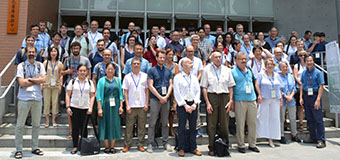Showing the results obtained at the Atacama UC Station, among others, was the objective that led the professors of the Institute of Geography Pablo Osses and Camilo del Río to participate in the 8th International Fog Conference, Fog and Dew Capture, held in Taipei.

Academics from the Institute of Geography, Pablo Osses and Camilo del Río, came to Tapei, in Taiwan. The objective: to present their research at the 8th International Fog Conference, Fog and Dew Capture.
This activity is conducted every three years, under the aegis of the International Fog and Dew Association (IFDA), of which Professor Osses is vice president. In total, the network brings together approximately 200 researchers from around the world, including academics, researchers and students.
“Almost all the attendees belong to universities or research centers, where studies of fog, mist water or dew are developed, from different approaches. They show the progress of their work, because the objective is to share knowledge, and since it is such a limited subject, there is a lot of interaction, ”says Pablo Osses.
The main theme of this congress is fog as a water resource. Under this premise, the academics presented on the monitoring of fog and cloud through satellite images, and the characterization of water availability in different places of Chile and Peru. “We bring three things: the satellite; water in the north of Chile, Tarapacá; and water from southern Peru, Arequipa. That was our knowledge to share, ”added Osses.
In this eighth version, different topics were addressed, among them: cloud physics, measurement techniques, modeling tools, climatology, interaction with vegetation, water resources, and chemical processes and pollution.
The works presented by the professors, which they developed in conjunction with other researchers, were: “Collection of mist water in the arid coastal desert of Atacama. Differences, contrast and coincidence between different geographical locations”, “GOFOS, Ground Optical Fog Observation System to monitor the dynamics of the vertical stratocumulus in the coastal desert of Atacama, Chile” and “Fog that produces water in the arid Peruvian coastal desert “.
The conference consisted of a week of exhibitions, debates and exchange of ideas, where there was also a field trip. On this occasion the researchers visited a “cloud forest”. “It is a tropical climate, the trees drip a lot, an extremely humid environment is created within the forest and it generates a lot of vegetation. It is a research station of the University of Taiwan,” explained Professor Osses.
Yet, how important is the Atacama UC Station in all this? The academic explains that “it is the base of operations to generate the knowledge that we are developing and presenting. And on the other hand, it is a magnet for new researchers and thesis students. It is vital for us to show it, so that people are motivated ”.
In addition to sharing new research, in these instances, said Professor Osses, “projects for two more years are built, contacts are made here and those that already exist are strengthened.”
The first two versions of this meeting were held in Canada (1998 and 2001), then in South Africa (2004), Chile (2007, in La Serena with a visit to the Fray Jorge National Park), Germany (2010), Japan (2013 ) and Poland (2016). The next conference will take place in Colorado, USA.
The Atacama UC Station is located 66 km from Iquique in the Tarapacá region and belongs to the Network of Regional Centers and Stations – RCER UC, made up of six UC field stations with presence in much of the national territory, from the Atacama desert to Patagonia.